MESSENGER Reveals Mercury as a Dynamic Planet
April 30, 2009 at 2 p.m. EST
Introduction
NASA's MErcury Surface, Space ENvironment, GEochemistry, and Ranging (MESSENGER) is the first mission sent to orbit the planet closest to the Sun. It will use Mercury's gravity for a critical assist needed to keep the spacecraft on track for its orbit insertion around the planet less than two years from now. During its second flyby of Mercury on October 6, 2008, MESSENGER's cameras captured more than 1,200 high-resolution and color images of the planet - unveiling another 30 percent of Mercury's surface that had never before been seen by spacecraft and gathering essential data for planning the overall mission. In a set of four papers published in Science magazine on May 1, 2009 MESSENGER team members detail additional findings about the planet's magnetosphere and exosphere, and its geological history. MESSENGER was launched on August 3, 2004. After one last pass at Mercury on September 29, 2009, the spacecraft will start a year-long orbital study of Mercury in March 2011.
MESSENGER Panelist Biographies
Presenter #1
Marilyn Lindstrom, MESSENGER Program Scientist
NASA Headquarters, Washington, D.C.
 |
Marilyn Lindstrom is the liaison between the MESSENGER principal investigator and the science team and NASA program management on science matters. She is responsible for overseeing science planning, implementation, analysis, and data archiving, as well as for facilitating MESSENGER science. Dr. Lindstrom is also program scientist for the Mars Fundamental Research program, Astromaterials Curation, and Planetary EPO. She previously managed the Planetary Instrument Definition and Development and Mars Data Analysis Programs. Prior to coming to Headquarters she was curator of Antarctic meteorites at NASA Johnson Space Center in Houston, and a research scientist studying rocks from the Earth, Moon, and Mars. She is particularly interested in comparative planetology of the terrestrial planets and is delighted to have a role in studying Mercury, the least known of these bodies.
Contact Information: (202) 358-1254
e-mail: marilyn.lindstrom-1@nasa.gov |
Presenter #2
William McClintock, MESSENGER Co-Investigator
University of Colorado, Laboratory for Atmospheric and Space Physics, Boulder, Colo.
 |
William McClintock, a Senior Research Scientist at the University of Colorado, Laboratory for Atmospheric and Space Physics, is an expert in upper planetary atmospheres and specializes in their measurement using ultraviolet spectroscopy. He led the development of the Mercury Atmospheric and Surface Composition Spectrometer (MASCS) and will lead the analysis of its measurements of atmospheric composition. He obtained both a BA in Physics and a PhD in Physics from the Johns Hopkins University. He joined the Laboratory for Atmospheric and Space Physics in 1977 to develop rocket experiments for observing interstellar matter. He serves as the SORCE SOLSTICE Instrument Scientist. In addition to his SORCE activities, he is a co-Investigator on a number of NASA planetary programs, including the Ultraviolet Imaging Spectrometer Experiment on the Cassini mission to Saturn and the MESSENGER mission. His research interests include the precise measurement of solar and stellar ultraviolet irradiance and ultraviolet observations of planetary atmospheres and exospheres.
Contact Information: (303) 492-8407
e-mail: William.McClintock@lasp.colorado.edu |
Presenter #3
James Slavin, MESSENGER Co-Investigator and Chief, Laboratory for Solar and Space Physics
NASA/Goddard Space Flight Center, Greenbelt, Md.
 |
James Slavin is a leading expert on planetary magnetospheres and how they interact with atmospheres and the solar wind. He shared in the development of MESSENGER's Magnetometer and is leading the analysis of the magnetospheric magnetic field measurements. Slavin has worked at the Caltech Jet Propulsion Laboratory, NASA Headquarters, and NASA GSFC. He is the author or co-author of over 250 scientific articles on Sun-Solar System connection physics. He has served as principal investigator, co-investigator, participating scientist, guest investigator, or team member for 19 magnetic field investigations, including the ongoing Cluster, WIND, and MESSENGER and the recently selected Magnetospheric MultiScale and BepiColombo missions. Slavin has also been project scientist, acting project scientist, deputy project scientist, or study scientist for five NASA missions.
Contact Information: (301) 286-5839
e-mail: james.slavin@gsfc.nasa.gov |
Presenter #4
Thomas Watters, MESSENGER Participating Scientist
Smithsonian Institution, Washington, D.C.
 |
Thomas Watters is the Senior Scientist of the Center for Earth and Planetary Studies of the National Air and Space Museum, Smithsonian Institution. He received his B.S. in Earth Science from West Chester University in 1977, his M.A. in Geology from Bryn Mawr College in 1979, and his Ph.D. in Geology from George Washington University in 1985. He joined the staff of the Center for Earth and Planetary Studies in 1984 as a research geologist and served as Chairman of the Center from 1989 to 1998. Watters is the director of the NASA Regional Planetary Image Facility housed in CEPS and is curator of the Museum's "Earth Today: A Digital View of our Dynamic Planet" display. His research interests are in planetary tectonics, geophysics, and remote sensing. His research involves the detailed characterization of tectonic landforms using image and topographic data, and the development of kinematic and mechanical models for their origin. Both analytical and numerical methods are employed in mechanical modeling of tectonic features. His research also involves geophysical modeling of tectonic stresses and understanding the mechanical and thermal structure of deformed planetary lithospheres. Watters has studied tectonic features on all the terrestrial planets and the Moon, as well as analog structures on the Earth.
Contact Information: (202) 633-2470
e-mail: watterst@si.edu |
Presenter #5
Brett Denevi, MESSENGER Imaging Team member and Postdoctoral Researcher
Arizona State University, Tempe, Ariz.
 |
Brett Denevi is a postdoctoral researcher at Arizona State University. She earned a B.A. in Geological Sciences from Northwestern University in 2002 and a Ph.D. in Geology and Geophysics from the University of Hawaii in 2007. Her research interests include the composition, origin, and evolution of planetary crusts, and she specializes in deriving compositional information from ultraviolet, visible, and near-infrared spectroscopy of planetary surfaces. She is currently working on the calibration and analysis of images from MESSENGER's Mercury Dual Imaging System (MDIS) and calibration and preparations for the Lunar Reconnaissance Orbiter Camera.
Contact Information: (301) 351-2219
e-mail: bdenevi@ser.asu.edu |
Resources
MESSENGER Reveals Mercury as a Dynamic Planet - April 30, 2009
Multimedia
Presenter #1
Marilyn Lindstrom, MESSENGER Program Scientist
NASA Headquarters, Washington, D.C.
Image 1.1
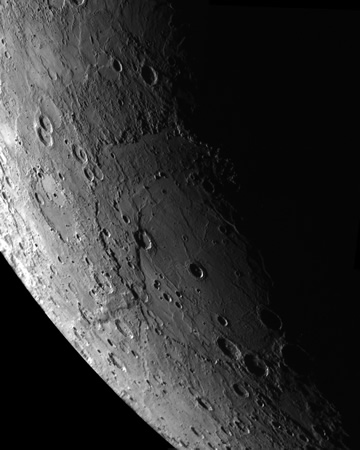
A mosaic of images collected by MESSENGER's Narrow Angle Camera as the spacecraft approached Mercury on October 6, 2008. The Rembrandt impact basin, 715 km in diameter, is seen at the center as night was falling across its eastern edge. An image similar to this one appears on the cover of the 1 May issue of Science magazine containing four articles on the latest results from that flyby.
Credit: Image produced by NASA/Johns Hopkins University Applied Physics Laboratory/Arizona State University/Carnegie Institution of Washington. Image reproduced courtesy of Science/AAAS.
Click on image to enlarge. |
Presenter #2
William McClintock, MESSENGER Co-Investigator
University of Colorado, Laboratory for Atmospheric and Space Physics, Boulder, Colo.
Image 2.1
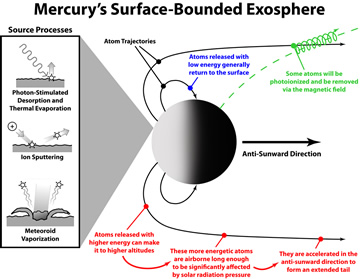
The panels on the left illustrate the three primary sources of exospheric material. Photon-stimulated desorption and evaporation result from incoming sunlight. Photon-stimulated desorption occurs when solar photons excite surface-bound atoms or molecules, causing them to be released to the exosphere. Sunlight also heats the surface causing atoms and molecules to evaporate. These are both low-energy source processes, so released material reaches only low altitudes in the exosphere and usually returns to the surface. Ion sputtering occurs when ions in the solar wind impact the surface, “knocking off” atoms and molecules. Meteoroid vaporization occurs when incoming meteoroids, generally small dust particles, impact Mercury’s surface, causing the local surface material to vaporize and enter the exosphere. Both ion sputtering and meteoroid vaporization are high-energy source processes, and the released material can reach high altitude and be accelerated in the anti-sunward direction by radiation pressure to form a neutral tail. Eventually atoms in the tail become ionized and escape along open magnetic field lines.
Credit: NASA/Johns Hopkins University Applied Physics Laboratory/University of Colorado/Carnegie Institution of Washington
Click on image to enlarge.
|
|
Image 2.2
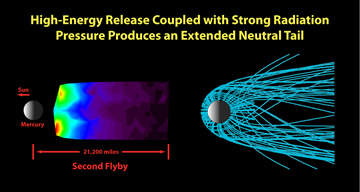
Left: An image of the neutral sodium emission, obtained during MESSENGER’s second flyby, reveals Mercury’s neutral tail, which extends away from the planet in the anti-sunward direction. In the image, north is up and the Sun is to the left. Because the observed emission intensity is related to the number of atoms along the line of sight, images such as this one are a measure of the density of the emitting species. The sodium emission shows two broad peaks that are located close to the planet to the north and south, and there is less emission near the equatorial region. Small-scale structures in the image may be artifacts of the viewing geometry. Right: A model calculation showing the trajectories of released Na atoms during the second flyby.
Credit: NASA/Johns Hopkins University Applied Physics Laboratory/University of Colorado/Carnegie Institution of Washington/University of Maryland
Click on image to enlarge.
|
|
Image 2.3
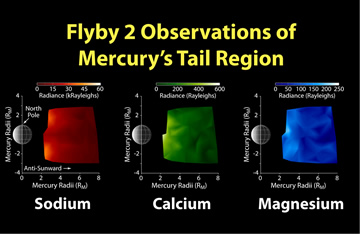
MASCS tail-region observations of sodium, calcium, and magnesium during the second MESSENGER flyby reveal marked differences in the distributions of these species. The sodium emission shows enhancements at both the northern and southern high latitudes that are likely a result of ion sputtering at high latitudes on the dayside. In contrast, the calcium distribution is peaked near the equatorial region and falls off at the higher latitudes, whereas the magnesium distribution is somewhat isotropic within the observation uncertainties but may show some evidence for high-latitude structure.
Credit: NASA/Johns Hopkins University Applied Physics Laboratory/University of Colorado/Carnegie Institution of Washington
Click on image to enlarge.
|
Presenter #3
James Slavin, MESSENGER Co-Investigator and Chief, Laboratory for Solar and Space Physics
NASA/Goddard Space Flight Center, Greenbelt, Md.
Image 3.1
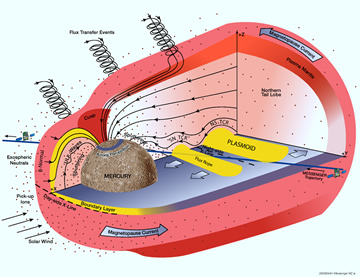
MESSENGER’s first flyby of Mercury in January 2008 revealed a quiet, stable magnetosphere with no measurable leakage of planetary magnetic flux across the magnetopause (the outer boundary) into the interplanetary medium. During the second flyby on October 6 (see image above), in contrast, MESSENGER observed a highly dynamic magnetosphere and measured large magnetic fields passing through the dayside magnetopause. The dynamics are indicated by the formation of large flux ropes (twisted magnetic flux tubes) at the dayside magnetopause and in the magnetic tail, where they are called flux transfer events and plasmoids, respectively. These phenomena are signatures of magnetic reconnection, a process that determines the degree of connectivity between the interplanetary magnetic field and a planet’s magnetic field. The rate of reconnection at Mercury in October was 10 times that typical at Earth.
Credit: Image produced by NASA/Goddard Space Flight Center/Johns Hopkins University Applied Physics Laboratory//Carnegie Institution of Washington. Image reproduced courtesy of Science/AAAS.
Click on image to enlarge.
|
Presenter #4
Thomas Watters, MESSENGER Participating Scientist
Smithsonian Institution, Washington, D.C.
Image 4.1
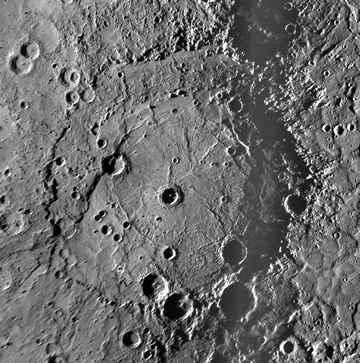
The Rembrandt impact basin was discovered by MESSENGER during its second flyby of Mercury in October 2008. Images show that the Rembrandt basin is remarkably well preserved. Most large impact basins on Mercury, the Moon, and other inner planets are flooded by volcanic flows that cover their entire floor. The number per area and size distribution of impact craters superposed on Rembrandt’s rim indicates that it is one of the youngest impact basins on Mercury.
Credit: NASA/Johns Hopkins University Applied Physics Laboratory/Smithsonian Institution/Carnegie Institution of Washington
Click on image to enlarge.
|
|
Image 4.2
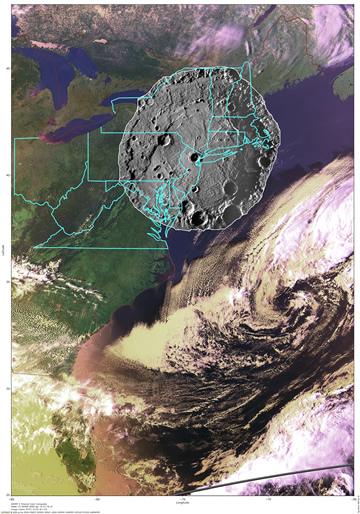
The Rembrandt impact basin revealed by MESSENGER during its second flyby of Mercury in October 2008 is shown here overlaid on an Advanced Very High Resolution Radiometer (AVHRR) image of the east coast of the United States. With a diameter of more than 700 km (430 miles), such a feature if formed at this location on Earth would encompass the cities of Washington, D.C., and Boston, Massachusetts, and everything in between.
Credit: NASA/Johns Hopkins University Applied Physics Laboratory/Smithsonian Institution/Carnegie Institution of Washington
Click on image to enlarge.
|
|
Image 4.3
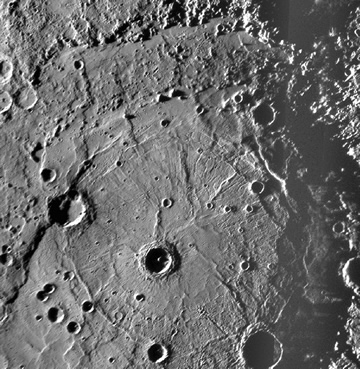
Exposed in portions of Rembrandt's floor is terrain preserved from when the impact basin formed. In most large impact basins this terrain is completely buried by volcanic flows erupted long after basin formation. Volcanic material does fill the central area of the Rembrandt basin and was deformed by tectonic forces into a complex pattern of ridges and troughs. Ridges formed during subsidence and contraction, and troughs formed during uplift and extension of the basin floor. Both types of deformation occurred after the interior volcanic flows were emplaced.
Credit: NASA/Johns Hopkins University Applied Physics Laboratory/Smithsonian Institution/Carnegie Institution of Washington
Click on image to enlarge.
|
|
Image 4.4
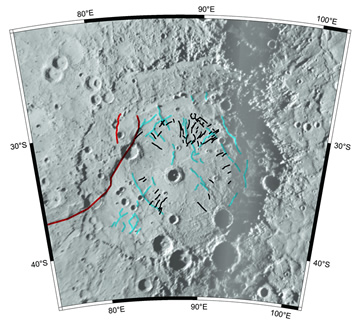
Ridges (in blue) and troughs (in black), deformational features created by crustal forces that acted on the solidified volcanic flows that partially filled the central area of the Rembrandt impact basin, form a "wheel-and-spoke-like" pattern. This pattern of tectonic landforms is unlike any seen in other impact basins in the Solar System. The longest thrust fault scarp (in red) yet discovered on Mercury, over 1000 km (620 miles) long and on the scale of the San Andreas Fault in California, cuts across the rim and floor of the Rembrandt basin.
Credit: NASA/Johns Hopkins University Applied Physics Laboratory/Smithsonian Institution/Carnegie Institution of Washington
Click on image to enlarge.
|
Presenter #5
Brett Denevi, MESSENGER Imaging Team member and Postdoctoral Researcher
Arizona State University, Tempe, Ariz.
Image 5.1
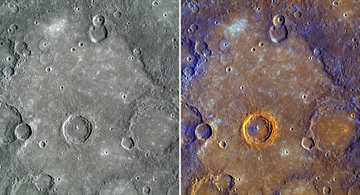
Just after MESSENGER's closest approach to Mercury (200 km from the surface), high-resolution color images of Mercury were obtained (500 meters per pixel). MESSENGER images the surface through 11 filters that span visible and infrared wavelengths. On the left, three visible colors (480 nm, 560 nm, 630 nm) were combined into a composite that approximates Mercury's color as it would be seen by the human eye. On the right, a statistical analysis of all 11 bands highlights subtle color differences on the surface. These images show color heterogeneity in color and (by inference) composition both horizontally and vertically. At the center, a crater 68 km in diameter exposes the stratigraphy (distribution of rock types with depth) of the region. Material with higher reflectance and a steeper spectral slope (bright orange in this view) is exposed in the ejecta near the crater rim. This material is most likely excavated from a smooth plains unit that is buried by the lower-reflectance plains unit seen surrounding the crater. A portion of the crater's central peak exposes material that is lower in reflectance, has a shallower spectral slope (blue in this color scheme), and has been uplifted by the cratering process from a depth of as much as 10 km. Similar material can be seen near the edges of the image along the degraded rim and ejecta of an ancient basin.
Credit: NASA/Johns Hopkins University Applied Physics Laboratory/Arizona State University/Carnegie Institution of Washington.
Click on image to enlarge.
|
|
Image 5.2

A subsurface interpretation of the surface units observed in Image 5.1. This interpretative cross section shows several layers of volcanic material (brown and yellow) that fill the degraded basin (rim indicated with arrows) and are exposed in the ejecta and central peak of the crater at center. Dark blue indicates areas interpreted to have an enhanced iron- and titanium content. This material appears to originate at depth, is exposed on the surface only through impact events, and may originate as cumulate deposits, formed when dense minerals settled out as they crystallized from a cooling magma. These same relationships are observed across the planet.
Credit: NASA/Johns Hopkins University Applied Physics Laboratory/Arizona State University/Carnegie Institution of Washington. Graphic by Sue Selkirk
Click on image to enlarge.
|
|
Image 5.3
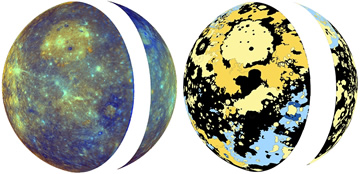
The global view: Mercury centered at longitude 180°E. On the left, Mercury in enhanced color (the white area indicates areas not yet viewed by MESSENGER with resolution and Sun angles suitable for color analysis). The Caloris impact basin can be seen as a distinctive circular feature near the top center (yellow in this color scheme). On the right, a preliminary interpretive map of Mercury's smooth plains (shades of yellow) and low-reflectance material (blues). The smooth plains cover approximately 40% of the surface mapped thus far. Low-reflectance material, thought to contain iron- and titanium-rich oxide minerals, affects the color and reflectance of at least 15% of the surface.
Credit: NASA/Johns Hopkins University Applied Physics Laboratory/Arizona State University/Carnegie Institution of Washington.
Click on image to enlarge.
|
|
Image 5.4
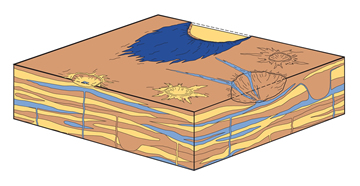
An interpretive block diagram of the complex vertical and lateral heterogeneities of Mercury's crust. Much of the crust may have accumulated through volcanic eruptions of lavas of varying composition. Impact craters later exposed material from depth. These cross sections are simplified; more complicated patterns of vertical and horizontal mixing are expected as a result of intrusions of rising magma and impacts of various sizes throughout the crustal formation process. Not to scale.
Credit: NASA/Johns Hopkins University Applied Physics Laboratory/Arizona State University/Carnegie Institution of Washington. Graphic by Sue Selkirk
Click on image to enlarge.
|
Contact Information
Paulette Campbell
The Johns Hopkins University Applied Physics Laboratory
Laurel, Maryland
Phone: (240) 228 - 6792
Dwayne Brown
NASA Headquarters
Washington, DC
Phone: (202) 358 -1726
Tina McDowell
Carnegie Institution of Washington
Washington, DC
Phone: (202) 939 -1120
Event Information
The NASA MESSENGER Media teleconference will take place on Thursday, April 30, 2009, at 1 p.m. EST. To participate in the teleconference, reporters in the United States should call 1-888-398-6118 and use the pass code "Mercury." International reporters should call 1-210-234-0013. Audio of the teleconference will be streamed live at: http://www.nasa.gov/newsaudio.

















